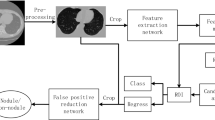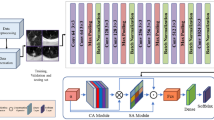Abstract
Early and precise detection of lung tumor cell is paramount for providing adequate medication and increasing the survivability of the patients. To achieve this, the Enhanced Faster R-CNN with MobileNetV2 and SCAM framework is bestowed for improving the diagnostic accuracy of lung tumor cell classification. The U-Net architecture optimized by Stochastic Gradient Descent (SGD) is employed to carry out clinical image segmentation. The developed approach leverages the advantage of the lightweight design MobileNetV2 backbone network and the attention mechanism called Spatial and Channel Attention Module (SCAM) for improving the feature extraction as well as the feature representation and localization process of lung tumor cell. The proposed method integrated a MobileNetV2 backbone network due to its lightweight design for deriving valuable features of the input clinical images to reduce the complexity of the network architecture. Moreover, it also incorporates the attention module SCAM for the creation of spatially and channel wise informative features to enhance the lung tumor cell features representation and also its localization to concentrate on important locations. To assess the efficacy of the method, several high performance lung tumor cell classification techniques ECNN, Lung-Retina Net, CNN-SVM, CCDC-HNN, and MTL-MGAN, and datasets including Lung-PET-CT-Dx dataset, LIDC-IDRI dataset, and Chest CT-Scan images dataset are taken to carry out experimental evaluation. By conducting the comprehensive comparative analysis for different metrics with respect to different methods, the proposed method obtains the impressive performance rate with accuracy of 98.6%, specificity of 96.8%, sensitivity of 97.5%, and precision of 98.2%. Furthermore, the experimental outcomes also reveal that the proposed method reduces the complexity of the network and obtains improved diagnostic outcomes with available annotated data.








Similar content being viewed by others
Availability of data and material
The data that support the findings of this study are available from the corresponding author upon reasonable request.
References
Alsheikhy AA, Said Y, Shawly T, Alzahrani AK, Lahza H (2023) A CAD system for lung cancer detection using hybrid deep learning techniques. Diagnostics 13(6):1174. https://doi.org/10.3390/diagnostics13061174
Amer A, Lambrou T, Ye X (2022) MDA-unet: a multi-scale dilated attention U-net for medical image segmentation. Appl Sci 12(7):3676. https://doi.org/10.3390/app12073676
Balasubramaniam S, Satheesh Kumar K, Kavitha V, Prasanth A, Sivakumar TA (2022) Feature selection and dwarf mongoose optimization enabled deep learning for heart disease detection. Comput Intell Neurosci. https://doi.org/10.1155/2022/2819378
Causey JL, Li K, Chen X, Dong W, Walker K, Qualls JA, Stubblefield J, Moore JH, Guan Y, Huang X (2020) Spatial pyramid pooling with 3D convolution improves lung cancer detection. IEEE/ACM Trans Comput Biol Bioinf 19(2):1165–1172. https://doi.org/10.1109/tcbb.2020.3027744
Chen W, Wang Y, Tian D, Yao Y (2023) CT lung nodule segmentation: a comparative study of data preprocessing and deep learning models. IEEE Access 11:34925–34931. https://doi.org/10.1109/ACCESS.2023.3265170
Chui KT, Gupta BB, Jhaveri RH, Chi HR, Arya V, Almomani A, Nauman A (2023) Multiround transfer learning and modified generative adversarial network for lung cancer detection. Int J Intell Syst 2023:1–14. https://doi.org/10.3390/electronics12153316
Faruqui N, Yousuf MA, Whaiduzzaman M, Azad AKM, Barros A, Moni MA (2021) LungNet: a hybrid deep-CNN model for lung cancer diagnosis using CT and wearable sensor-based medical IoT data. Comput Biol Med 139:104961. https://doi.org/10.1016/j.compbiomed.2021.104961
Fu X, Bi L, Kumar A, Fulham M, Kim J (2021) Multimodal spatial attention module for targeting multimodal PET-CT lung tumor segmentation. IEEE J Biomed Health Inform 25(9):3507–3516. https://doi.org/10.1109/jbhi.2021.3059453
Grossman R, Haim O, Abramov S, Shofty B, Artzi M (2021) Differentiating small-cell lung cancer from non-small-cell lung cancer brain metastases based on MRI using efficient net and transfer learning approach. Technol Cancer Res Treat 20:15330338211004920. https://doi.org/10.1177/15330338211004919
Hu H, Li Q, Zhao Y, Zhang Y (2020) Parallel deep learning algorithms with hybrid attention mechanism for image segmentation of lung tumors. IEEE Trans Industr Inf 17(4):2880–2889. https://doi.org/10.1109/TII.2020.3022912
Humayun M, Sujatha R, Almuayqil SN, Jhanjhi NZ (2022) A transfer learning approach with a convolutional neural network for the classification of lung carcinoma. Healthcare 10(6):1058. https://doi.org/10.3390/healthcare10061058
Josphineleela R, Raja Rao PBV, Shaikh A, Sudhakar K (2023) A multi-stage faster RCNN-Based iSPLInception for skin disease classification using novel optimization. J Digi Imaging. https://doi.org/10.1007/s10278-023-00848-3
Laqua FC, Woznicki P, Bley TA, Schöneck M, Rinneburger M, Weisthoff M, Schmidt M, Persigehl T, Iuga AI, Baeßler B (2023) Transfer-learning deep radiomics and hand-crafted radiomics for classifying lymph nodes from contrast-enhanced computed tomography in lung cancer. Cancers 15(10):2850. https://doi.org/10.3390/cancers15102850
Li P, Wang S, Li T, Lu J, HuangFu Y, Wang D (2020) A large-scale CT and PET/CT dataset for lung cancer diagnosis (Lung-PET-CT-Dx). Cancer Imaging Arch. https://doi.org/10.7937/TCIA.2020.NNC2-0461
Li M, Ma X, Chen C, Yuan Y, Zhang S, Yan Z, Chen C, Chen F, Bai Y, Zhou P, Lv X (2021) Research on the auxiliary classification and diagnosis of lung cancer subtypes based on histopathological images. IEEE Access 9:53687–53707. https://doi.org/10.1109/ACCESS.2021.3071057
Liu K (2022) Stbi-yolo: a real-time object detection method for lung nodule recognition. IEEE Access 10:75385–75394. https://doi.org/10.1109/ACCESS.2022.319203
Mahum R, AlSalman A (2023) Lung-RetinaNet: lung cancer detection using a retinanet with multi-scale feature fusion and context module. IEEE Access 11:53850–53861. https://doi.org/10.1109/ACCESS.2023.3281259
Naseer I, Akram S, Masood T, Rashid M, Jaffar A (2023) Lung cancer classification using modified U-net based lobe segmentation and nodule detection. IEEE Access 11:60279–60291. https://doi.org/10.1109/ACCESS.2023.3285821
Nguyen CC, Tran GS, Burie JC, Nghiem TP (2021) Pulmonary nodule detection based on faster R-CNN with adaptive anchor box. IEEE Access 9:154740–154751. https://doi.org/10.1109/ACCESS.2021.3128942
Qiao B, Jumai K, Ainiwaer J, Niyaz M, Zhang Y, Ma Y, Zhang L, Luh W, Sheyhidin I (2022) A novel transfer-learning based physician-level general and subtype classifier for non-small cell lung cancer. Heliyon. https://doi.org/10.1016/j.heliyon.2022.e11981
Qureshi R, Zou B, Alam T, Wu J, Lee V, Yan H (2022) Computational methods for the analysis and prediction of EGFR-mutated lung cancer drug resistance: recent advances in drug design, challenges and future prospects. IEEE/ACM Trans Comput Biol Bioinf 20(1):238–255. https://doi.org/10.1109/tcbb.2022.3141697
Ren S, He K, Girshick R, Sun J (2015) Faster r-cnn: Towards real-time object detection with region proposal networks. Adv Neural Inform Process Syst. https://doi.org/10.48550/arXiv.1506.01497
Sabzalian MH, Kharajinezhadian F, Tajally A, Reihanisaransari R, Alkhazaleh HA, Bokov D (2023) New bidirectional recurrent neural network optimized by improved Ebola search optimization algorithm for lung cancer diagnosis. Biomed Signal Process Control 84:104965. https://doi.org/10.1016/j.bspc.2023.104965
Sahu HP, Kashyap R (2023) Fine_denseiganet: automatic medical image classification in chest CT scan using hybrid deep learning framework. Int J Image Graph. https://doi.org/10.1142/S0219467825500044
Said Y, Alsheikhy AA, Shawly T, Lahza H (2023) Medical images segmentation for lung cancer diagnosis based on deep learning architectures. Diagnostics 13(3):546. https://doi.org/10.3390/diagnostics13030546
Saleh AY, Chin CK, Penshie V, Al-Absi HRH (2021) Lung cancer medical images classification using hybrid CNN-SVM. Int J Adv Intell Inform 7(2):151–162. https://doi.org/10.26555/ijain.v7i2.317
Srinivasulu A, Ramanjaneyulu K, Neelaveni R, Karanam SR, Majji S, Jothilingam M, Patnala TR (2021) Advanced lung cancer prediction based on blockchain material using extended CNN. Appl Nanosci 13:1–13. https://doi.org/10.1007/s13204-021-01897-2
Suji RJ, Bhadouria SS, Dhar J, Godfrey WW (2020) Optical flow methods for lung nodule segmentation on LIDC-IDRI images. J Digi Imaging 33:1306–1324. https://doi.org/10.1007/s10278-020-00346-w
Tazin T, Sarker S, Gupta P, Ayaz FI, Islam S, Monirujjaman Khan M, Bourouis S, Idris SA, Alshazly H (2021) A robust and novel approach for brain tumor classification using convolutional neural network. Comput Intell Neurosci. https://doi.org/10.1155/2021/2392395
Tiwari L, Raja R, Awasthi V, Miri R, Sinha GR, Alkinani MH, Polat K (2021) Detection of lung nodule and cancer using novel Mask-3 FCM and TWEDLNN algorithms. Measurement 172:108882. https://doi.org/10.1016/j.measurement.2020.108882
Wang X, Wang L, Zheng P (2022) SC-dynamic R-CNN: a self-calibrated dynamic R-CNN model for lung cancer lesion detection. Compu Math Methods Med. https://doi.org/10.1155/2022/9452157
Wang Z, Yu F, Wang D, Liu T, Hu R (2023) Multi-threshold segmentation of breast cancer images based on improved dandelion optimization algorithm. J Supercomput. https://doi.org/10.21203/rs.3.rs-3129915/v1
Wankhade S, Vigneshwari S (2023) A novel hybrid deep learning method for early detection of lung cancer using neural networks. Healthc Anal 3:100195. https://doi.org/10.1016/j.health.2023.100195
Xiang D, Zhang B, Lu Y, Deng S (2022) Modality-specific segmentation network for lung tumor segmentation in PET-CT images. IEEE J Biomed Health Inform 27(3):1237–1248. https://doi.org/10.1109/jbhi.2022.3186275
Yin XX, Sun L, Fu Y, Lu R, Zhang Y (2022) U-net-based medical image segmentation. J Healthc Eng. https://doi.org/10.1155/2022/4189781
Zhang Y, Feng W, Wu Z, Li W, Tao L, Liu X, Zhang F, Gao Y, Huang J, Guo X (2023a) Deep-learning model of ResNet combined with CBAM for malignant-benign pulmonary nodules classification on computed tomography images. Medicina 59(6):1088. https://doi.org/10.3390/medicina59061088
Zhang L, Slade S, Lim CP, Asadi H, Nahavandi S, Huang H, Ruan H (2023b) Semantic segmentation using Firefly Algorithm-based evolving ensemble deep neural networks. Knowl Based Syst 277:110828. https://doi.org/10.1016/j.knosys.2023.110828
Zhu X, Wang X, Shi Y, Ren S, Wang W (2022) Channel-wise attention mechanism in the 3D convolutional network for lung nodule detection. Electronics 11(10):1600. https://doi.org/10.3390/electronics11101600
Fan T, Wang G, Wang X, Li Y, Wang H (2021) MSN-Net: a multi-scale context nested U-Net for liver segmentation. Signal Image Video Process 15:1089–1097. https://link.springer.com/article/10.1007/s11760-020-01835-9
Hany M (2020) Chest CT-scan images dataset. Kaggle. The dataset is available at https://www.kaggle.com/datasets/mohamedhanyyy/chest-ctscan-images. Retrieved November 13: 2022
Jena SR, George ST, Ponraj DN (2021) Lung cancer detection and classification with DGMM-RBCNN technique. Neural Comput Appl 33:15601–15617. https://link.springer.com/article/10.1007/s00521-021-06182-5
Nancy W, Prianka RR, Porselvi R Jt AR (2023) DeepRetNet: retinal disease classification using attention UNet++ based segmentation and optimized deep learning technique. https://doi.org/10.21203/rs.3.rs-3348299/v1
Funding
Not applicable.
Author information
Authors and Affiliations
Corresponding author
Ethics declarations
Conflict of interest
The authors declare that they have no conflict of interest.
Ethics approval
This article does not contain any studies with human participants.
Human and animal rights
This article does not contain any studies with human or animal subjects performed by any of the authors.
Informed consent
Informed consent was obtained from all individual participants included in the study.
Consent to participate
Not applicable.
Consent for publication
Not applicable.
Additional information
Publisher's Note
Springer Nature remains neutral with regard to jurisdictional claims in published maps and institutional affiliations.
Rights and permissions
Springer Nature or its licensor (e.g. a society or other partner) holds exclusive rights to this article under a publishing agreement with the author(s) or other rightsholder(s); author self-archiving of the accepted manuscript version of this article is solely governed by the terms of such publishing agreement and applicable law.
About this article
Cite this article
Jenipher, V.N., Radhika, S. Lung tumor cell classification with lightweight mobileNetV2 and attention-based SCAM enhanced faster R-CNN. Evolving Systems (2024). https://doi.org/10.1007/s12530-023-09564-3
Received:
Accepted:
Published:
DOI: https://doi.org/10.1007/s12530-023-09564-3




